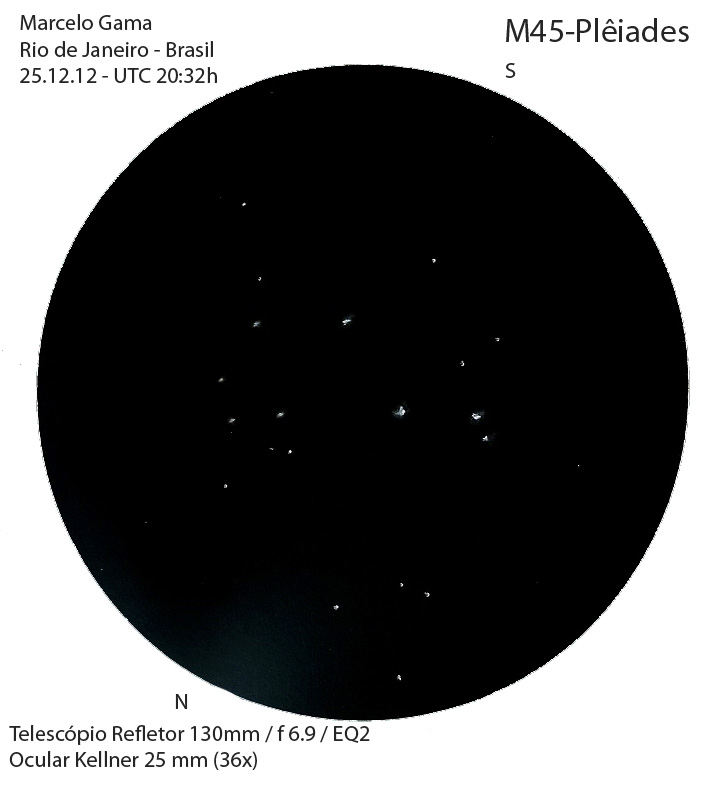
Object Type – Open Cluster
Location – Rio de Janeiro / Brasil
Date – 25.12.12 / 20:32 h UTC
Media – graphite pencil, white paper, photoshop
Equipament –
130 mm / f 6.9 / EQ2 Newtonian Telescope
Ocular 25 mm Kellner
Stellarium
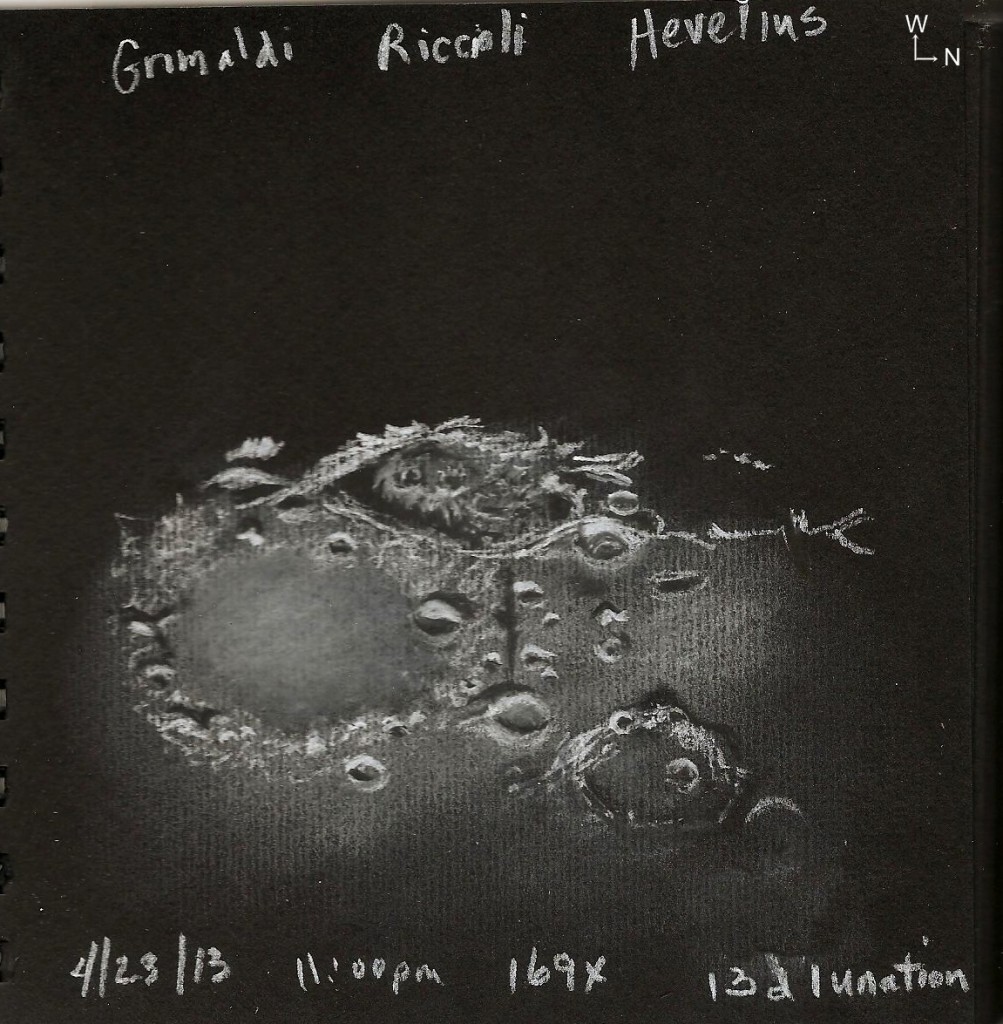
Riccioli and Grimaldi Craters
Move cursor over image to view labels.
Aloha!
After a bit of a slump, I decided to get out & observe a little of our Moon. On the lunar west limb I spotted 2 craters that appeared so different from one another that I was intrigued. I knew that one was Grimaldi but was not certain about the other. I sat down to sketch at the eyepiece on a night of good seeing conditions in Hawaii.
Riccioli Crater is the large (140 km) lunar impact crater at the western terminus of the sketch. It is bordered to the southeast by the larger (230 km) Grimaldi & to the northwest by Hevelius. Hedin is still in the darkness and only the edge becoming lit.
Riccioli appears elongate with rough crater walls casting sharp jagged shadows into the basin. There is also visible roughness & debris within the crater. This debris & other striated formations in the region are believed to have been created by ejecta from the formation of the Orientale impact basin to the southwest not seen here. The roughness of Riccioli is in stark contrast to Grimaldi which appears smooth by comparison. Grimaldi, covered in lava makes it appear more like a mare than a crater.
There appears to be a dark line or peak running from Riccioli to crater Lohrmann directly to the east. Multiple small brightly lit rimmed craters surround this area. A double crater with 2 bright rims of light can be seen at the northeast edge of Riccioli.
Both Riccioli & Grimaldi craters were named by 17th century Jesuit priests & colleagues Francesco Maria Grimaldi & Giovanni Baptista Riccioli, who were responsible for many of the names given to features on the Moon today.
Thia (Cindy) Krach
12.5” Portaball 169x
Maui, Hawaii
4/23/13
Black Fabriano paper
white & black charcoal pencils
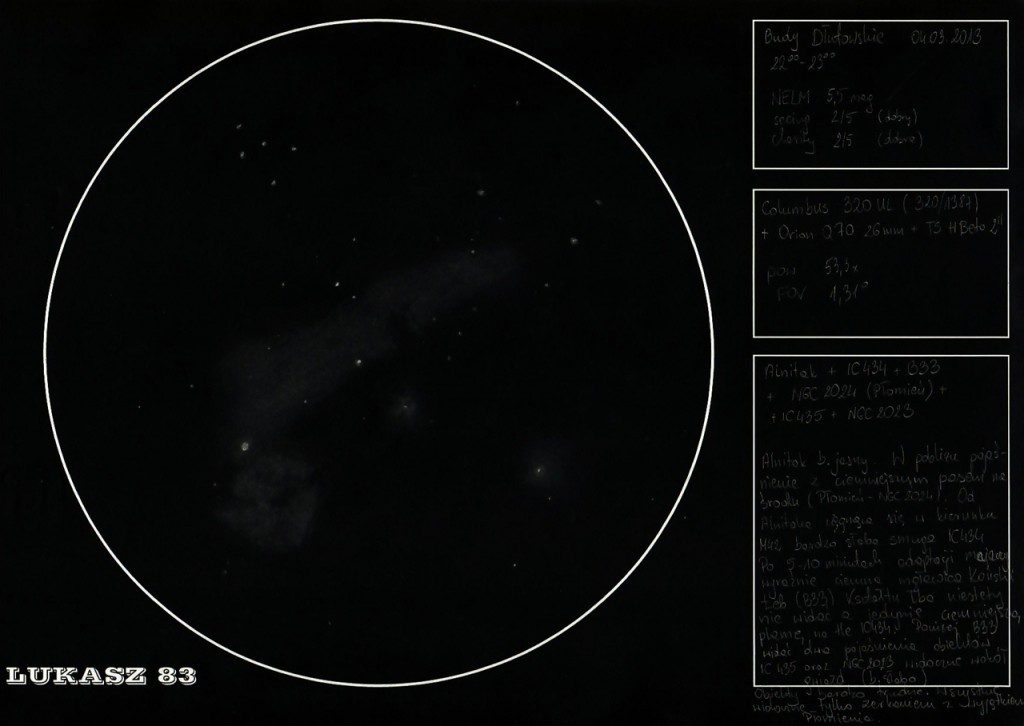
Hi,
In attachment you can find sketch of nebulas complex in Orion around
Alnitak – NGC 2024 (Flame Nebula), IC434 and B33 (Horsehead Nebula),
IC435, NGC 2023
Short description:
Object Name NGC 2024 (Flame Nebula), IC434 and B33
(Horsehead Nebula), IC435, NGC 2023
Object Type emission nebulas and dark nebula (Barnard 33)
Location Budy Dłutowskie – small village in central Poland
Date 04.03.2013
Media graphite pencil, white paper, color invert
Telescope Columbus 320UL (320/1384 Newtonian) +
Orion Q70 26mm + TS H-Beta 2”’
Seeing 2/5 (good)
Transparency 2/5 (good)
NELM 5,5 mag
I’ve heard that is possible to observe B33 under medium sky
condtitions (5-6mag) using 12” or bigger scope and H-Beta filter and
I’ve wondered is it true… In 2012 I bought 2” TS B-Beta filter and
after some months of really bad weather in Poland I tried it three
days ago.
When you looking thru the eyepiece you can see Alnitak and misty
shadow of flame nebula. All views using H-beta filter are really dark
so you need few minutes for eye adaptation and you need also to cut
off from all external light sources (using some towel on head or
something like that 🙂 ).
After this adaptation really faint fog of IC434 will appear and in the
middle you can observe small black roundy shaped place in this nebula
– this is the shape of B33.
You won’t observe horsehead shape in 12-16” telescope probably even
in extremely good sky conditions. To see horeheadshape you need 18”
or bigger scope and H-Beta filter.
But its worth to try to observe it. It’s a challenge which can give
you knowledge how you can “detect” and observe really faint objects.
Clear Sky
Łukasz
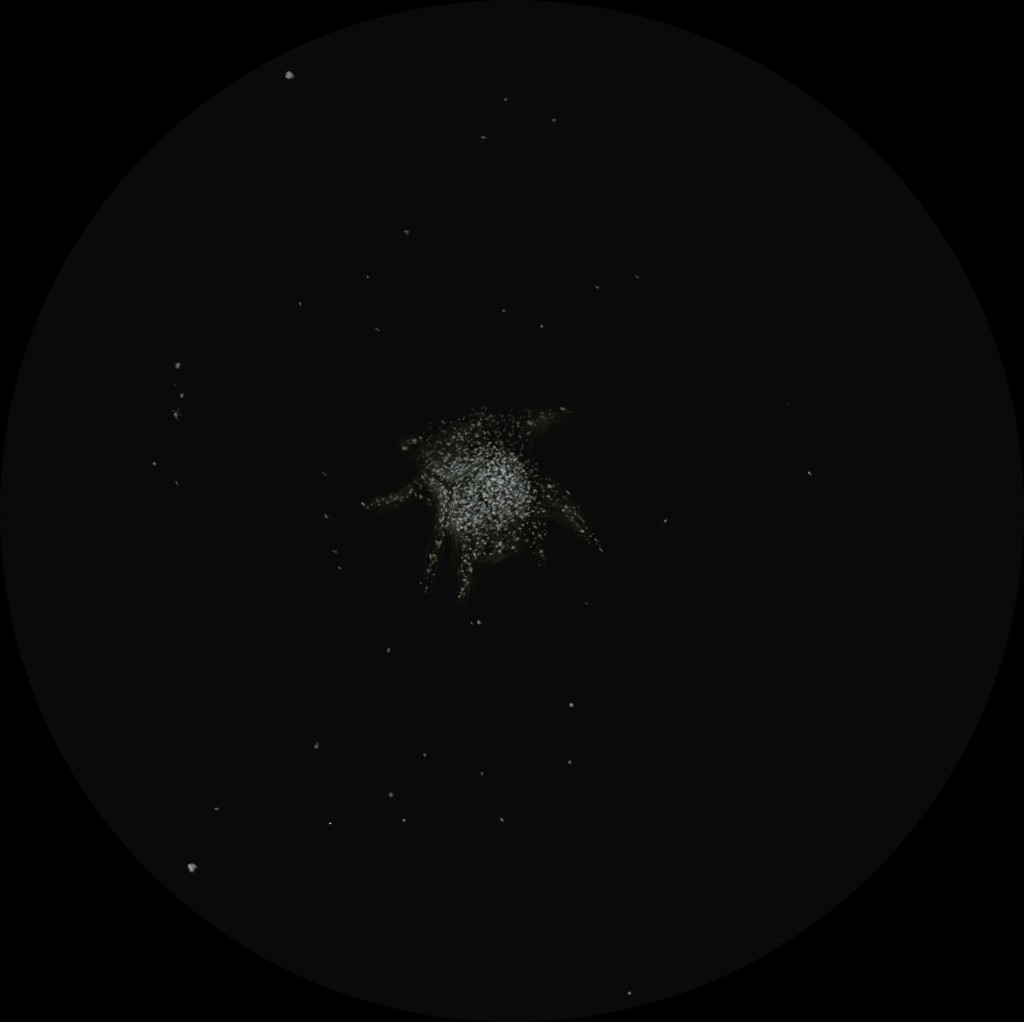
Object Name : M13
Object Type : The Great Globular Cluster in Hercules
Location : But-gogae Yangdong-myeon Yangpyeong-gun Gyeonggi-do South.KOREA
Date : 2013.5.1 thursday
Media : A4 paper, HB pencil
Equipment : 12.5′ dobsonian, XW 14mm
Observing conditions : Clear sky
I could identify propeller in M13
Spent a hour to sketch, 24:00 ~ 01:00
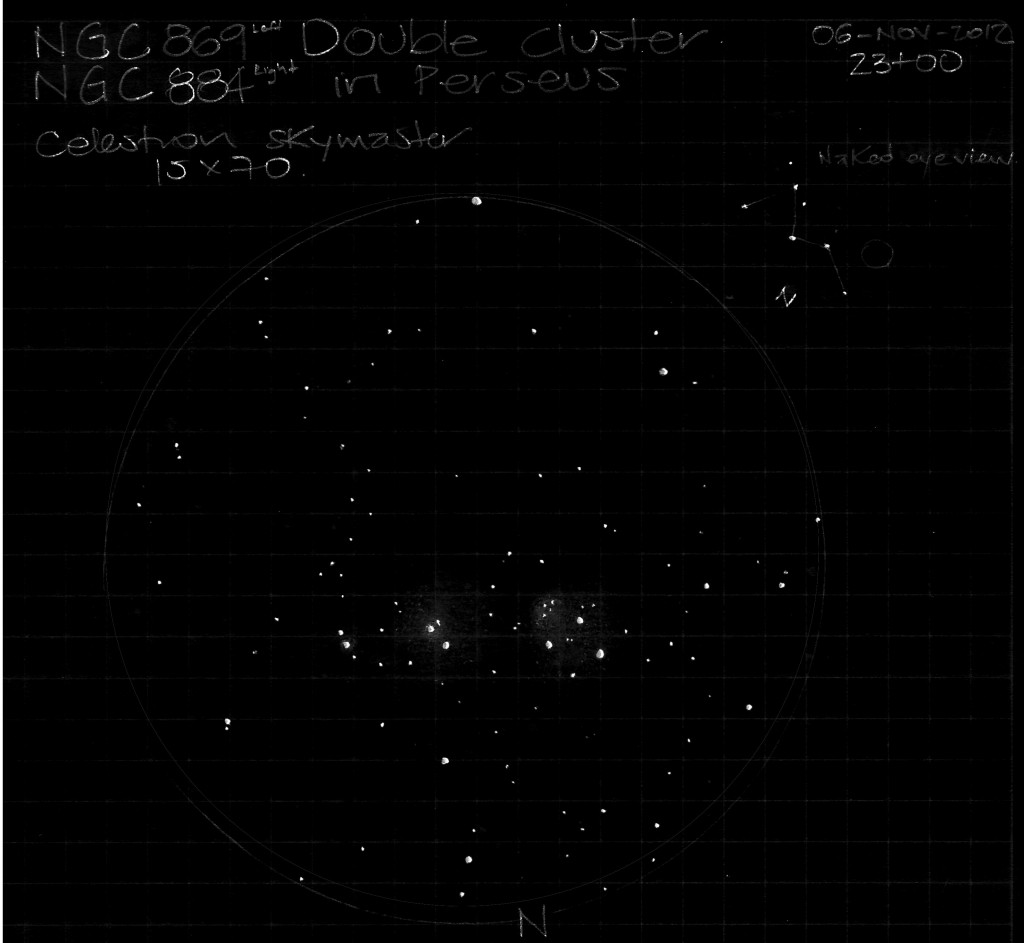
Object name: Double cluster in Perseus NGC 869 and NGC 884
Object type: Open cluster
Location: Bogotá, Colombia.
Date: 06-NOV-2012
Media: Graphite pencil and yellow notebook paper. Scanned and inverted.
Equipment: 15X70 Binoculars
Hello all,
Since June of the last year i started this hobbie to sketch the objects i saw from my very light polluted area. As a begginer i think is a good way to learn and memorize the sky. This page and also ronys site are my favorites and i would like to make a page like that. Unfortunately i still have some problems trying to make better my sketches by using photoshop.
This sketch was performed on 3 nights of observation and it was easy to find from deltha Cas because my view of Perseus is obstructed by my neighbor building. In the denses areas of the cluster i can not resolve the stars but they together are seen like an clearer area compared with the reddish/blue (becasue LP) background.
Thanks to all for watching.
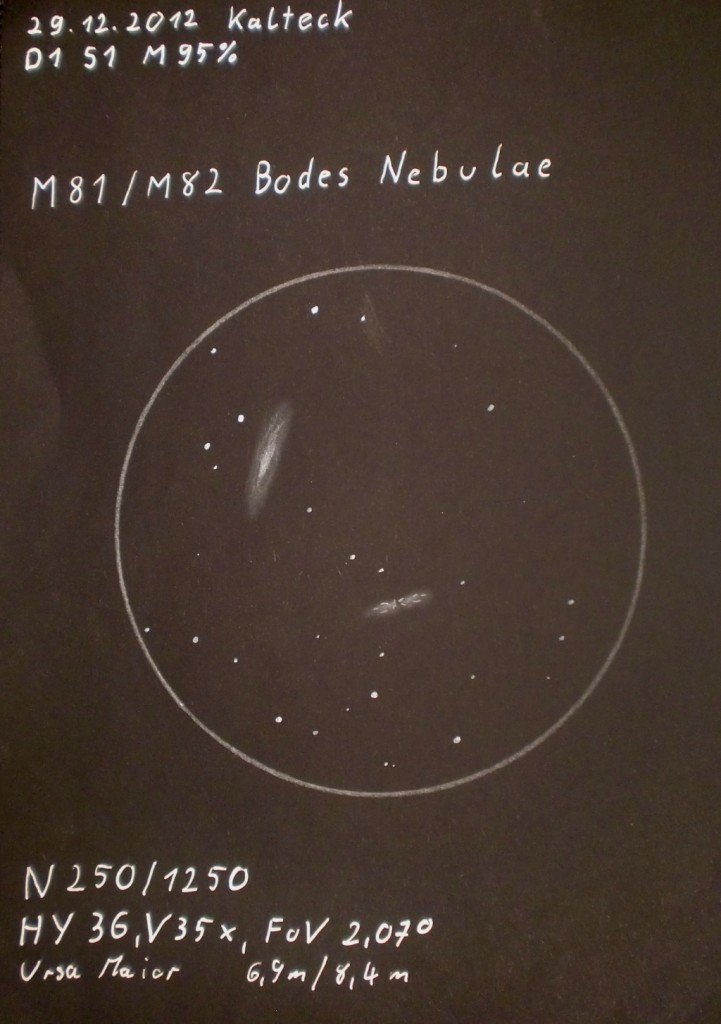
Object: M81\M82 Galaxies in Ursa Major
Scope: 10″ Newtonian
Eyepiece: 36mm Baader Hyperion, FoV 2,07°
Date of scetch: 12.29.2012
Location: Kalteck, Bavaria, Germany
Just before the New year me and my buddy packed our gear and went on a small mountain where we occasionally enjoy the Nightsky . Though my friend is more into photographic Astronomy we sometimes try our skills at the same Objects and share our Scetches\Photos what’s great to compare. Especially if someone asks you if you can see all the colors and details through your scope that they know from Hubble images in Media.
It was a pretty good night with excellent seeing and good transparency. Only 95% illuminated Moon was a little annoying then. Bodes Nebulae are always a nice view.
Made a few scetches that night. This is my first one to post here. There’ll probably be more.
Clear skies
Thorsten
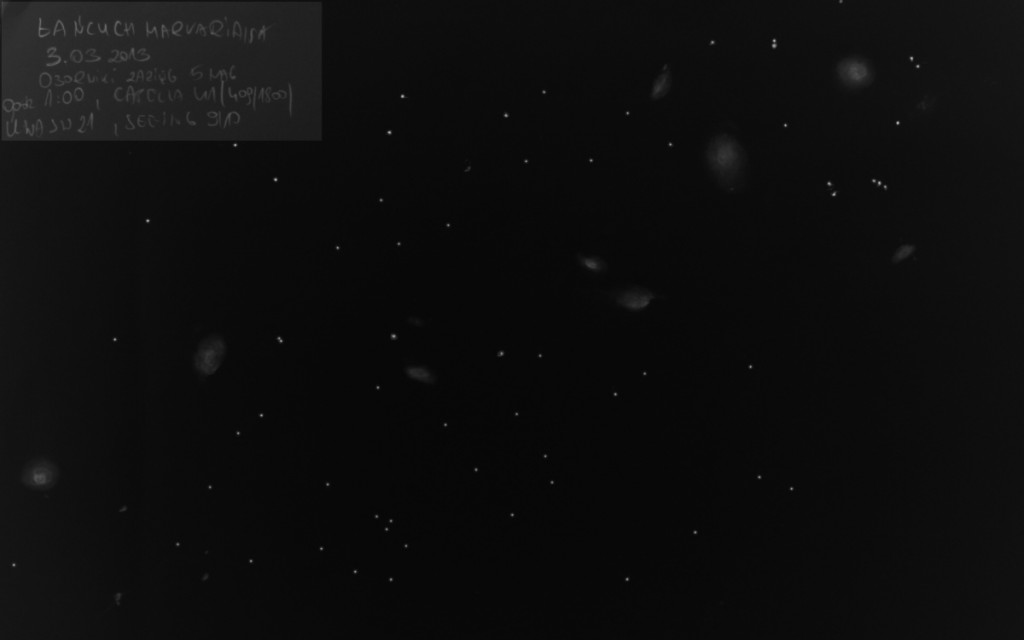
Markarian’s Chain superb spring object, this curved line of galaxies is my favorite part of the Virgo Cluster. I sketched 10 of them visible in the 16-inch telescope in small-town suburbia (naked eye limiting magnitude is about 5)
I noticed exactly 10 galaxies from the left:
Ngc 4477
Ngc 4473
Ngc 4458
Ngc 4461
Ngc 4435
Ngc 4438
Ngc 4402
M86
M84
Mgc 4388
Of course, the sketch doesn’t represent the field of view 72 degrees (22mm, eyepiece)- it was just sketched by moving the tube 😉 Power is almost about 82x
Yours Robert
Sketch details:
Object Name: Markarian’s Chain
Object Type: Group of galaxies
Location: Poland, Oborniki
Date: 03-03-2013
Equipment: Newtonian telescope 409/1800 (Capella 41), and 22 mm eyepiece
Object: – Artist: Robert Twarogal (Ignisdei)
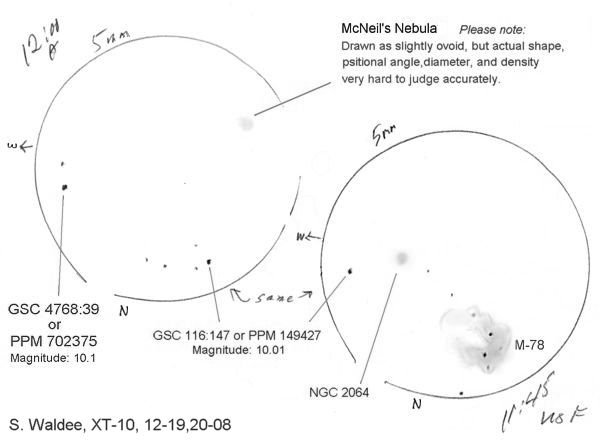
Friends:
Here is my submission, which is, I think, not only my best sketch to date, but also my most valuable one: as I cannot find any other one of the nebula during its short 2008 outburst.
* Object Name (McNeil’s Nebula)
* Object Type (Likely emission nebulosity, outburst of V1647 Ori)
* Location (Santa Cruz mountains, north of Santa Cruz, California)
* Date (12-20-08)
* Media (graphite pencil, white black paper)
The sketch was made in my logbook after a long study about the the nebula, careful preparation of regional charts, and intense scrutiny during a session arranged just for this observation, using my Orion XT-10 Sky Quest 10 inch Dobsonian (f/4.7, 5 mm Orion Stratus eyepiece [240x, 1.1 mm exit pupil, ~17′ FOV], without filtration.)
Sue French, “Deep Sky Wonders” columnist for “Sky & Telescope” magazine, had carefully observed the previous outburst of McNeil’s nebula in 2004, with a 10″ Newtonian (confirmed by Joe Bergeron.) She studied my report and first and second drawings, and commented in reply, “You no doubt saw McNeil’s reflection nebula.”
My lengthy article about the nebula, and this observation, is found at:
http://freescruz.com/~4cygni/astro-app/essays/fuzzy-objects09.htm#McNeil
This article discusses the meteorological conditions, and many other aspects of my quest to see it, and the actual experience, plus my background research. The viewing location was a rural private road in the Santa Cruz mountains, south of San Jose and north of Santa Cruz, at an elevation of 3,400 feet (site of some previous Don Machholz comet discoveries.) The drawing shown was confirmed by me with a second sighting and sketch made with a C-11 telescope, at Lake San Antonio further south, on 12-28-08.
Respectfully submitted,
Stephen R. Waldee
amateur astronomer, San Jose
Manager: Roper Piano Studio
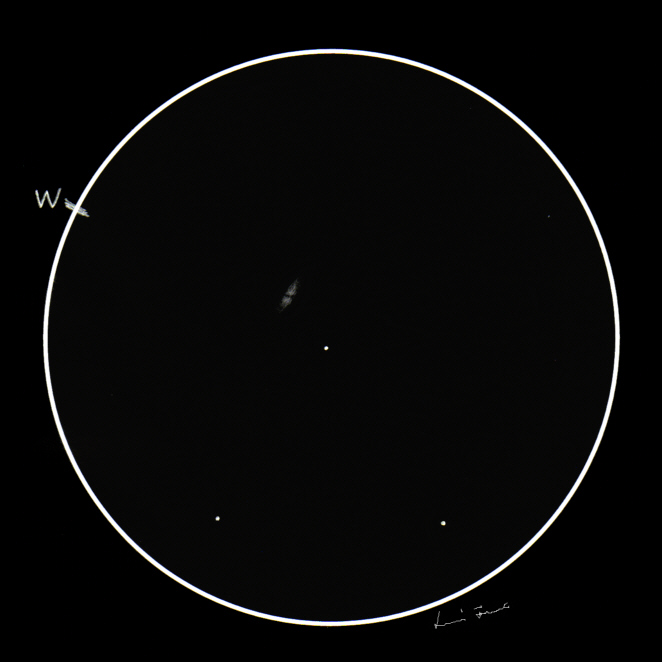
Object name: Frosty Leo (IRAS 09371+1212)
Object type: protoplanetary nebula
Location: Nádasdladány, Hungary
Date: 2013.03.07 21:15 UT
Media: B + 5B pencils on white paper, inverted digitally
Telescope: 12″ f/5 Newtonian on Dobsonian mount
Magnification: 469x
Seeing, transparency, SQM: 5/1, 3/5, 21.16 MPSAS
Temperature: 280 K
Description:
A rarely observed protoplanetary nebula I’ve first read about in Cloudy Night’s Sketching forum. It’s as small as expected, but much fainter. Elongated to the N-S, with a clearly visible dark band divinding the nebula to to halves, when the seeing gets better for a few moments. Reminds me of a faint little nearly edge-on galaxy. I haven’t checked photos of this object before my observation, so I’m quite surprised now that I’ve seen the dark band, because even on a sketch made with 600mm scope it does not show up. But I know that my eye did not lie. A highly recommended gem.
Cheerio, Ferenc